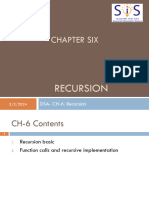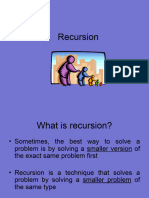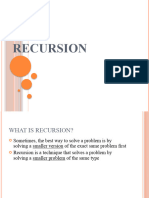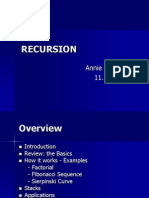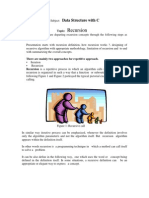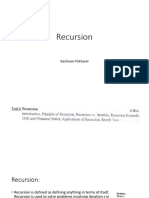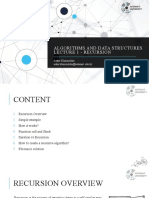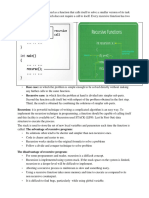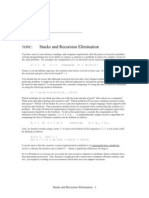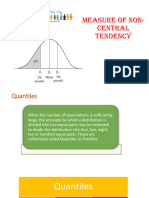Data Structures & Algorithms
Stack & Recursion
Today‘s lecture
▪ Stacks
► Practical applications
- Stacks in validating expressions
- Infix to Postfix conversion & evaluation
- Algorithms implementing stack
- To convert any Infix expression into its corresponding Postfix
expression
- To evaluate any postfix expression
- Postfix/Prefix forms do not rely on operator priorities, a tie
breaker,
or delimiters
- Easier evaluation of expressions
- Unambiguous expression tree
- Adding very large integer numbers
▪ Recursion
Lecture 7: Stack & Recursion 2
Another stack application example:
Adding very large integers
▪ Consider adding very large numbers
► Since the largest magnitude of integers is limited (32
bits), so we are not able to perform following:
18,274,364,583,929,273,748,459,595,684,373
+
8,129,498,165,026,350,236
because integer variables cannot hold such large values
▪ The problem can be solved if we
► treat these numbers as strings of numerals,
► store the numbers corresponding to these numerals on two
stacks, and
► then perform addition by popping numbers from the stacks
Lecture 7: Stack & Recursion 3
Pseudocode
addingLargeNumbers()
► Read the numerals of the first number and store the
numbers corresponding to them on one stack;
► Read the numerals of the second number and store
the numbers corresponding to them on another
stack;
► carry = 0;
► while at least one stack is not empty
- pop a number from each nonempty stack and
add them to carry;
- push the unit part on the result stack;
- store carry in carry;
► push carry on the result stack if it is not zero;
► pop numbers from the result stack and display
them; Lecture 7: Stack & Recursion 4
Lecture 7: Stack & Recursion 5
Today‘s lecture
▪ Stacks
► Practical applications
- Stacks in validating expressions
- Infix to Postfix conversion & evaluation
- Algorithms implementing stack
- To convert any Infix expression into its corresponding Postfix
expression
- To evaluate any postfix expression
- Postfix/Prefix forms do not rely on operator priorities, a tie
breaker,
or delimiters
- Easier evaluation of expressions
- Unambiguous expression tree
- Adding very large integer numbers
▪ Recursion
Lecture 7: Stack & Recursion 6
Recursive thinking
▪ Recursion is a problem-solving approach that can be
used to generate simple solutions to certain kinds of
problems that would be difficult to solve in other ways
▪ Recursion splits a problem into one or more simpler
versions of itself
► These sub-problems may also be divided into further
smaller sub-sub-problems
▪ A recursive call is a function call in which the called
function is the same as the one making the call
Lecture 7: Stack & Recursion 7
Recursive Definitions
▪ Recursive algorithm
► Algorithm that finds the solution to a given problem by
reducing the problem to smaller versions of itself
► Has one or more base cases
► Implemented using recursive functions
▪ Recursive function
► Function that calls itself
Lecture 7: Stack & Recursion 8
Recursive Definitions
▪ Base case
► Case in recursive definition in which the solution is
obtained directly
► Stops the recursion
▪ General case
► Case in recursive definition in which a smaller version of
itself is called
► Must eventually be reduced to a base case
Lecture 7: Stack & Recursion 9
Outline of a recursive function
if (answer is known)
provide the answer Base case
else
make a recursive call to Recursive case
solve a smaller version
of the same problem
Lecture 7: Stack & Recursion 10
Tracing a recursive function
▪ Recursive function
► May have unlimited copies of itself
► Every recursive call has
- its own code
- own set of parameters
- own set of local variables
▪ After completing recursive call
► Control goes back to calling environment
► Recursive call must execute completely before control
goes back to previous call
► Execution in previous call begins from point immediately
following recursive call
Lecture 7: Stack & Recursion 11
How Recursion Works?
▪ Recursive function call is handled like any other
function call
▪ Each recursive call has an activation record or a stack
frame
► Stores values of parameters and local variables
▪ When base case is reached, return is made to previous
call
► Recursion “unwinds”
Lecture 7: Stack & Recursion 12
Factorial definition
4! = 4 * 3 * 2 * 1
n! = n * (n-1) * … * 1
4! = 4 * 3!
n! = n * (n-1)!
factorial(n) = n * factorial(n-1) // recursive step
factorial(1) = 1 // base step
1 𝑖𝑓𝑛 = 0
n! =
𝑛∗𝑛−1! 𝑖𝑓 𝑛 > 0
Lecture 7: Stack & Recursion 13
Recursive factorial function
int fact(int num)
{
if(num == 0)
return 1;
else
return num * fact(num – 1);
}
Lecture 7: Stack & Recursion 14
Recursive factorial function fact(4) = 24
num = 4;
since num != 0 return = 4 * 6
int fact(int num) return 4*fact(3);
fact(3) fact(3) = 6
{
num = 3; return = 3 * 2
if(num == 0) since num != 0
return 1; return 3*fact(2);
else fact(2) fact(2) = 2
num = 2; return = 2 * 1
return num * fact(num – 1); since num != 0
} return 2*fact(1);
fact(1) fact(1) = 1
num = 1; return = 1 * 1
Recursive factorial trace since num != 0
return 1*fact(0);
fact(0) fact(0) = 1
num = 0; return = 1
since num == 0
15
return 1;
Another recursive definition
Fibonacci sequence: 0, 1, 1, 2, 3, 5, 8, 13, 21, ...
0 𝑓𝑜𝑟 𝑛 == 0
1 𝑓𝑜𝑟 𝑛 == 1
𝑓𝑖𝑏 𝑛 =
𝑓𝑖𝑏 𝑛 − 2 + 𝑓𝑖𝑏 𝑛 − 1 𝑓𝑜𝑟 𝑛 > 2
fib(n) = fib(n-1) + fib(n-2) Recursive case
fib(0) = 0 Base case
fib(1) = 1
Lecture 7: Stack & Recursion 16
Recursive Fibonacci repeats computations
int fib (int n)
{
if (n == 0) {
return 0; }
else if (n == 1) {
return 1; }
else {
return fib (n-1) + fib (n-2); }
}
Lecture 7: Stack & Recursion 17
Evaluating Exponents Recursively
double power (double x, unsigned int n) // raise x to the power n
{
if (n == 0)
return 1.0;
else
return x * power(x,n-1);
}
Using this definition, the value of x4 can be computed in the
following way:
x4 = x · x3 = x · (x · x2) = x · (x · (x · x1)) = x · (x · (x · (x · x0)))
= x · (x · (x · (x · 1))) = x · (x · (x · (x))) = x · (x · (x · x))
= x · (x · x · x)= x · x · x · x
Lecture 7: Stack & Recursion 18
Implementation using loop
The function power() can also be implemented
differently, without using any recursion, as in the
following loop:
double nonRecPower(double x, unsigned int n) {
double result = 1;
for (result = x; n > 1; --n)
result *= x;
return result;
}
Do we gain anything by using recursion
instead of a loop?
M. Shahzad: Data Structures & Algorithms Lecture 7: Stack & Recursion 19
Recursion or iteration?
▪ The recursive version seems to be more intuitive
because it is similar to the original definition of the
power function. The definition is simply expressed in
C++ without losing the original structure of the
definition
▪ The recursive version increases program
readability, improves self-documentation, and
simplifies coding
▪ In the example, the code of the nonrecursive version is
not substantially larger than in the recursive version,
but for most recursive implementations, the code is
shorter than it is in the non-recursive implementations
M. Shahzad: Data Structures & Algorithms Lecture 7: Stack & Recursion 20
Recursive vs iteration
▪ In iteration, a loop repetition condition determines
whether to repeat the loop body or exit from the loop
▪ In recursion, the condition usually tests for a base case
▪ You can always write an iterative solution to a problem
that is solvable by recursion
▪ Recursive code may be simpler than an iterative
algorithm and thus easier to write, read, and debug
M. Shahzad: Data Structures & Algorithms Lecture 7: Stack & Recursion 21
When to use recursion?
▪ If recursive and iterative algorithms are of similar
efficiency
► Prefer iteration over recursion
▪ If the problem is inherently recursive and a recursive
algorithm is less complex to write than an iterative
algorithm
► Prefer recursion over iteration
Lecture 7: Stack & Recursion 22
Efficiency of recursion
▪ Recursive methods often have slower execution times
when compared to their iterative counterparts
► Because the overhead for loop repetition is smaller than
the overhead for a method call and return
▪ If it is easier to conceptualize an algorithm using
recursion, then you should code it as a recursive
method
► Because sometimes the reduction in efficiency does not
outweigh the advantage of readable code that is easy to
debug
Lecture 7: Stack & Recursion 23
Pitfalls of recursion
▪ One pitfall of recursion is infinite regress, i.e. a chain of
recursive calls that never stops
► E.g. if you forget the base case. Make sure you have
enough base cases
▪ Recursion can be less efficient than an iterative
implementation. This can happen because there is
recalculation of intermediate results
▪ There can be extra memory use because recursive
calls must be stored on the execution stack
Lecture 7: Stack & Recursion 24
Function calls & recursive implementation
▪ The state of each function, including main(), is characterized
► by the contents of all local variables,
► by the values of the function’s parameters, and
► by the return address indicating where to restart in the
calling function
▪ The data area containing all this information is called an
activation record or a stack frame and is allocated on the
run-time stack
► exists for as long as a function owning it is executing
▪ This record is a private pool of information for the function, a
repository that stores all information necessary for its proper
execution and how to return to where it was called from
Lecture 7: Stack & Recursion 25
Activation Record / Stack Frame
▪ If a function is called either by
main() or by another function,
then its stack frame is created
on the run-time stack
▪ The run-time stack always
reflects the current state of the
function
► E.g., suppose that main() calls
function f1(), f1() calls f2(), and
f2() in turn calls f3(). If f3() is
being executed, then the state
of the run-time stack is as
shown
Lecture 7: Stack & Recursion 26
Activation Record / Stack Frame
▪ An activation record usually contains the following
information
► Values for all parameters to the function, location of the first
cell if an array is passed or a variable is passed by reference,
and copies of all other data items;
► Local variables that can be stored elsewhere, in which case,
the activation record contains only their descriptors and
pointers to the locations where they are stored;
► The return address to resume control by the caller, the
address of the caller’s instruction immediately following the
call;
► A dynamic link, which is a pointer to the caller’s activation
record;
► The returned value for a function not declared as void.
Because the size of the activation record may vary from one
call to another, the returned value is placed right above the
activation record of the caller
Lecture 7: Stack & Recursion 27
Evaluating Exponents Recursively
double power (double x, unsigned int n) /* 102 */
{
if (n == 0) /* 103 */
return 1.0; /* 104 */
else
return x * power(x,n-1); /* 105 */
}
int main()
{ ...
y = power(5.6,2); /* 136 */
...
}
Lecture 7: Stack & Recursion 28
First, the value of the second argument, i.e., 2, is checked,
and power() tries to return the value of 5.6 * power(5.6,1)
double power (double x, unsigned int n) { /* 102 */
if (n == 0) /* 103 */
return 1.0; /* 104 */
else
return x * power(x,n-1); } /* 105 */
Lecture 7: Stack & Recursion 29
Again first, the value of the second argument, i.e., 1, is checked,
and power() tries to return the value of 5.6 * power(5.6,0)
double power (double x, unsigned int n) { /* 102 */
if (n == 0) /* 103 */
return 1.0; /* 104 */
else
return x * power(x,n-1); } /* 105 */
Lecture 7: Stack & Recursion 30
double power (double x, unsigned int n) { /* 102 */
if (n == 0) /* 103 */
return 1.0; /* 104 */
else
return x * power(x,n-1); } /* 105 */
Lecture 7: Stack & Recursion 31
Again, first, the value of the
second argument, i.e., 0, is
checked, and power()
returns the value 1
At this point, there are two
pending calls on the run-time
stack—the calls to power()—
that have to be completed
double power (double x, unsigned int n) { /* 102 */
if (n == 0) /* 103 */
return 1.0; /* 104 */
else
return x * power(x,n-1); } /* 105 */
Lecture 7: Stack & Recursion 32
5.6 * power(5.6,0)
= 5.6 * 1 = 5.6 is
computed
double power (double x, unsigned int n) { /* 102 */
if (n == 0) /* 103 */
return 1.0; /* 104 */
else
return x * power(x,n-1); } /* 105 */
Lecture 7: Stack & Recursion 33
5.6 * power(5.6,0)
= 5.6 * 1 = 5.6 is
computed
double power (double x, unsigned int n) { /* 102 */
if (n == 0) /* 103 */
return 1.0; /* 104 */
else
return x * power(x,n-1); } /* 105 */
Lecture 7: Stack & Recursion 34
5.6 * power(5.6,1)
= 5.6 * 5.6 = 31.36
is computed
double power (double x, unsigned int n) { /* 102 */
if (n == 0) /* 103 */
return 1.0; /* 104 */
else
return x * power(x,n-1); } /* 105 */
Lecture 7: Stack & Recursion 35
5.6 * power(5.6,1)
= 5.6 * 5.6 = 31.36
is computed
double power (double x, unsigned int n) { /* 102 */
if (n == 0) /* 103 */
return 1.0; /* 104 */
else
return x * power(x,n-1); } /* 105 */
Lecture 7: Stack & Recursion 36




















